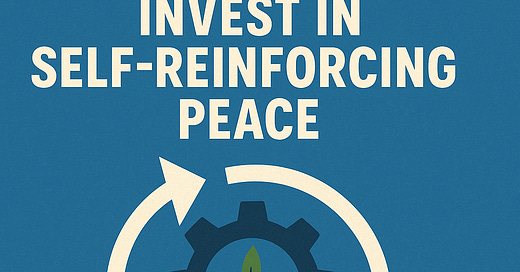3 Ways to Spot a Peace Investment in Systems (Not Just Projects)
Much of traditional peacebuilding hasn’t been an investment in enduring change. If we want sustainable peace, we need to invest in systems that make peace self-reinforcing.
Much of traditional peacebuilding hasn’t been an investment in enduring change.
Traditional projects have been short-term, siloed, and underfunded. They can do real good for the people who participate in the project, but they rarely touch the underlying systems that perpetuate conflict in the first place.
If we want sustainable peace, we need to invest in systems that make peace self-reinforcing. This systems approach does not just fix problems once, it changes the conditions so those problems are resolved and don’t return.
So what does a systems-level peace investment actually look like?
Here are 3 signals investors, philanthropists, and institutions can look for.
1. The investment strengthens long term resilience
A sustainable peace investment embeds people and institutions in regenerative systems that continue to deliver value long after donors exit.
Example: In Rwanda, ex-combatants have launched successful businesses as contractors providing water and sanitation services in urban areas. These enterprises generate income, contribute to essential public infrastructure, and support public health, economic growth, and social reintegration.
Why it works: This model connects reintegration of former combatants to long-term national priorities, like access to clean water. By rooting livelihoods in public service delivery, it embeds former combatants in roles that reinforce both civic identity and community benefits, which have carried on well beyond the typical lifespan of donor-funded programs.
2. The investment builds connective tissue
Although we’ve constructed international aid systems that have put peace in a silo, in reality it touches multiple other sectors and levels (individual, group, national, international). Systems-level investments weave together sectors and actors—government, civil society, private sector, and communities—so that peace isn’t a program, but a shared responsibility that reinforces cooperation and nonviolent conflict resolution.
Example: In Colombia, UNHCR and UNDP jointly supported the creation of territorial multi-stakeholder platforms in areas most affected by violence. These platforms brought together local governments, ex-combatants, civil society, private sector actors, and international donors to jointly plan and monitor peace and development activities.
Critically, the platforms were aligned with the national Territorial Development Plans and supported value chain development, job creation, and reintegration. In several municipalities, committees were formed that included businesses, local institutions, and academic partners, helping ensure that local development was peace-sensitive, economically grounded, and community-driven.
Why it works: By creating structured, multi-actor governance platforms, this model channels public budgets and private investment into strategic development priorities. It also enables communities to advocate for their needs, building trust, accountability, and resilience across sectors, not just within one. This creates a mutually reinforcing incentive for cooperation in furtherance of shared benefits and, yes, peace.
3. The investment is structured for learning and adaptation
Complex, volatile, and uncertain environments demand adaptability. Approaches that don’t evolve breakdown or become irrelevant. But approaches that learn and adapt to the dynamic context stand a much better chance of shifting systems and actors toward the kind of resilience and interconnectivity described in examples 1 and 2.
Example: In Kenya, the Kiunga Youth Bunge Initiative (KYBI) emerged as a peace actor during a period of escalating instability in East Africa. Supported by USAID’s PEACE II and III programs and implemented by Pact, the initiative evolved from a grassroots youth group into a specialist peacebuilding institution in Kenya’s conflict-affected Lamu region near the Somalia border.
When Kenya’s military incursion into Somalia in 2011 sparked violence, distrust, and radicalization, KYBI pivoted. With support and flexible funding from PEACE II, they shifted focus to peacebuilding and reconciliation. Under PEACE III, KYBI established cross-border security committees to address real-time tensions related to trade, health, education, and security. This helped build trust between local actors and reduce vulnerability to recruitment by armed groups.
Why it works: This initiative wasn’t locked into a fixed implementation model, and had access to flexible funding that enabled it to adapt. It responded to evolving conflict dynamics, adapted its structure, and built multi-stakeholder forums rooted in local needs. In fast-changing environments, that kind of real-time responsiveness is essential to avoid escalation and foster lasting peace.
Final Thought
Peace is investable.
The best peace investments establish nonviolent mechanisms to resolve conflict, deliver services, and build durable systems. This approach outlasts the donor, adapts to change, interlocks into other systems, and continues generating value for the communities they serve.
This isn’t easy or fast work. But it stands a far greater chance of enduring change, which our world desperately needs.
What would you add to this list?
Have you seen examples of peace systems that truly worked, or failed spectacularly?
I’d love to hear your experience.




